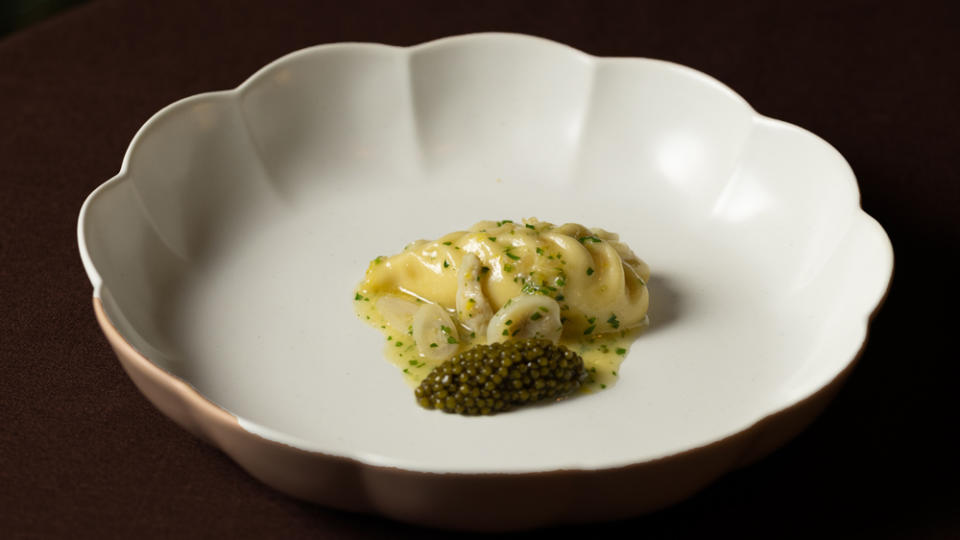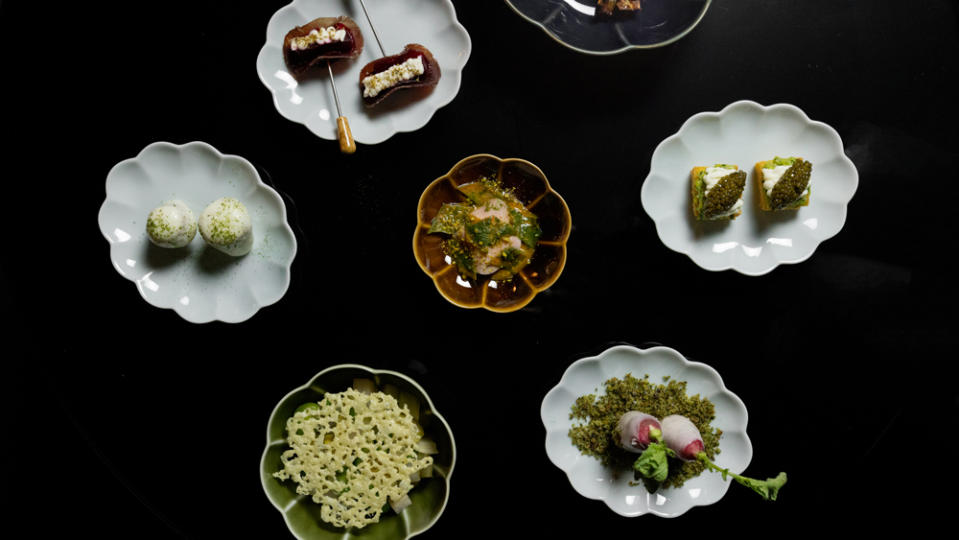Inside Al Coro, a New NYC Restaurant That Makes Italian Fine Dining Feel Like a Party

Italian fine dining, according to chef Melissa Rodriguez, is an oxymoron. “It’s a fine line to dress it up and take it out,” she says. “You’re walking a tightrope.” Push the less-is-more cooking too far and you squelch its spirit, not far enough and diners start to question exactly why they’re paying $245 a pop for dinner. But Rodriguez, who recently opened Al Coro with partner Jeff Katz, is confident as a high-wire cook. “I like doing things people tell me I can’t do,” she says.
Al Coro, housed in the former Del Posto space in Chelsea, is a near impossible project on paper. Rodriguez ran the Del Posto kitchen after Marc Ladner’s departure in 2017. Katz had taken over as general manager eight years earlier, and when the landmark restaurant closed for Covid-19 in 2020 and permanently in 2021, the duo bought the business and set about gutting the space, exercising the demons of former owner Mario Batali and reimagining what fine dining should feel like post-pandemic. And they did it all in a 24,000-square-foot piece of real estate that really should only work as an Equinox or Tao-like clubstaurant and on a block with former mega restaurant neighbors—Atelier de Joël Robuchon, Morimoto, and Toro—conspicuously absent, killed off by Covid. There are 150 seats to fill, not to mention private dining and a forthcoming downstairs bar, Discolo.
More from Robb Report
At Lysée, Michelin-Starred Pastry Chef Eunji Lee Creates Some of NYC's Most Artistic Confections
The Pandemic Caused NYC's Wealthy to Leave in Unprecedented Numbers
Eleven Madison Park Scrapped Plans to Give Staff a Living Wage After a Critical 'NY Times' Review
Al Coro isn’t just a swing for Italian fine dining. It’s got to prove that New York still supports big ideas.
For Katz and Rodriguez, buying Del Posto, rather than starting fresh elsewhere, was obvious. “Why would we leave?” says Katz. “We spent so long in the space, it was pretty easy to start thinking about what could have been better or different.”
Al Coro’s renovations rid Del Posto of its “New Jersey funeral home” vibes, an opening-week guest told Katz. The grand staircase is gone, replaced by a nine-seat bar with liquor bottles backlit and aglow. White linens were swapped for chocolate tabletops.

Natalie Black
A moodboard for Discolo included Wilt Chamberlain’s bedroom and Yves Saint Laurent’s living room, and some of that throwback aesthetic made it upstairs in the restaurant’s custom chrome and micro-suede furniture.
Mostly, Katz and Rodriguez wanted to purge any hint of fussiness, and opening Mel’s, their wood-fired pizzeria, earlier this year helped loosen everyone up. Rodriguez hadn’t worked in a casual restaurant for two decades and found herself stripping away ideas and components from dishes. “Your normal developmental behaviors have to be questioned,” she says. “And the same thing goes for service in the dining room. Why are we still doing all these steps?”
The pandemic, too, broke restaurants—fine dining and otherwise. While much of Del Posto’s management team (the food and beverage director, pastry chef, chef de cuisine, director of operations, kitchen manager, events director, facilities director and head pasta maker, among others) returned to open Al Coro, they were ready to do things differently.
“We don’t want the place to feel like it’s stuck with a bunch of rules, because that forces you as the guests to feel like you’ve got a bunch of rules to follow,” Katz says. “I don’t think everybody wants to be so buttoned up.”
But diners do want a show, especially at a restaurant like Al Coro that’s built for celebrations and blow-outs, and in place of exaggerated service steps and tableside theater, they’re getting it with live music. A balcony-as-stage now anchors the dining room, where rotating bands will perform each night. The evening I visited, vocalist Alicia Olatuja, dressed in a silver-sequined dress, sang from this mezzanine, framed like the Madonna by newly constructed arches.
Live music, of course, can be experienced elsewhere in New York City. But Rodriguez’s cooking is only available at 85 10th Avenue: covered with molten cheese at Mel’s and, according to the chef, “tried and practiced and ripped apart into a million pieces,” at Al Coro.

Natalie Black
The restaurant’s opening menu ($245 for seven courses and $195 for five) is full of regional Italian deep cuts flipped and edited by a razor-sharp New Yorker. The seven antipasti are one-bite teases that snap your brain and palate into focus. Radishes dipped in buffalo brown butter look like a high-end catering crudité, but they’re centers are hollowed out and stuffed with a humble but forceful purée of anchovies and turnips. Thinly shaved bresaola cradles its doppelganger beet, and tiny fried artichokes are a crunchy vessel for electric colatura caramel, candied lemon, magenta pickled red onion and mint.
Culurgiones, those fat Sardinian dumplings shaped to resemble a grain of wheat, play high and low. They’re filled with potato, fontina and mascarpone and served with razor clams and a substantial quenelle of caviar. For her version of southern Italian anelletti al forno, Rodriguez’s pasta team braids strands of dough by hand into perfect, toothsome rings—all the better looking and for catching tiny bites of escarole and braised pork cheek.
A riff on chicken marsala (a dish hailing from the American school of Italian cooking) is no cheap and familiar thrill. Rodriguez makes the sauce with mushroom stock, dashi, and a marsala reduction and, in a gluten-free sleight of hand, thickens it with quinoa purée. Black sea bass stands in for chicken, the fish stuffed with mushroom duxelle and set atop a meaty, chewy king trumpet mushroom. Texturally bold and earthy, I had to contemplate the dish for a few days before its homey origins even dawned on me.
In the last few years, so much of the high-end dining I’ve eaten (and enjoyed) has felt rather obvious and safe. But that’s not Rodriguez’ game at Al Coro. “The meal has moments that are a little overwhelming and fun and then more precious and serious,” she says.
If you were to put those sentiments in a matrix, the meal’s final savory course would fall under high fun, mid-low overwhelming and serious, and low precious. Inspired by the proximity of New York’s Little Italy and Chinatown and based on a dish she cooked for an event, Rodriguez makes a Peking duck set with a Sicilian backbone. First-off, she replaced the duck with a chicken that’s brined overnight and then dried for 10 days. After some steaming and curing of respective parts, the breast is presented thinly sliced and served over a warm chicken leg salad. That’s the serious technical part. And the fun? The chicken comes with bowls of cherry mostarda, fennel slaw, spring caponata and Italian chile crisp to garnish as you please, and there’s a stack of farinata pancakes to use in lieu of forks for scooping and assembling bites (overwhelming for Westerners freaked out by eating with their hands).

Natalie Black
“We hope we get to a place where guests feel comfortable enough to make the mess,” says Katz. “You’re paying for that. We’ll clean it up.”
Desserts from Georgia Wodder mirror the bite-sized antipasti format so you can experience lots of little joys without feeling like you have to power through a final course. Pop a lemon verbena meringue in your mouth followed by a miniature tartufa alla fragola that gushes with vanilla mascarpone and strawberry cardamaro caramel. Little slabs of Sicilian brioche are topped with fennel gelato and cantaloupe granita—no spoon necessary. And for those diners who need a decadent and clear end to the meal, Wodder delivers a bittersweet, potent and rich chocolate crostata with espresso gelato and a balsamic drizzle. There’s no dish that could follow it.
Open for only a few weeks, it’s early for Al Coro. The team is still building the wine cellar and tweaking service. Rodriguez will update the menu every month, and Katz expects to adjust the music and experience as they go—but only up to a point. “If you’re going to have some kind of point of view, and try to do something a little bit unique, you’re going to have people who don’t love it,” says Katz. “And that has to be okay. Because if not, the restaurant starts to feel a little vanilla.”
The fact is: vanilla sells for a lot these days. But outside the bombastic tartufa alla fragola, you won’t find much of it at Al Coro, a restaurant that makes it feel like we’re truly stepping out of the pandemic. There’s the sense of joy and celebration, yes, but not without risk or at the expense of being original and challenging—a metaphor for New York if I’ve even eaten one.
Best of Robb Report
The Ultimate Guide to Wagyu Beef, the World's Most Luxurious Steak
Why a Heritage Turkey Is the Best Thanksgiving Bird—and How to Get One
The 10 Best Wines to Pair With Steak, From Cabernet to Malbec
Sign up for Robb Report's Newsletter. For the latest news, follow us on Facebook, Twitter, and Instagram.

 Yahoo Movies
Yahoo Movies 